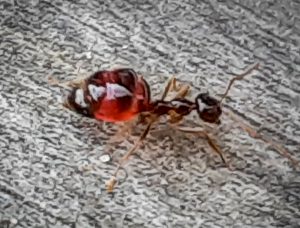False Honey Ant


The False Honey Ant or Winter Ant, Prenolepis imparis, is a small ant (workers 2.5-3.5 mm; queen about 8 mm) that has a range that covers most of the US, southern Ontario, and Mexico. They are very cold-tolerant, but their range is believed not to extend all that deep into the most northerly latitudes.
Young workers are deliberately ‘overfed,’ and although it looks as though their abdomens are about to burst with honey, it’s in actuality a special type of fat; hence, the “false honey” aspect of their name. The fat that is stored in their abdomen subsequently produces a nutritious secretion that the workers and winged reproductives depend upon for food throughout the remainder of the year when the ants remain confined to their nest.
False honey ants usually build their nest in open but shaded soil that has some clay content, or sometimes in wooded situations, and occasionally you’ll find them under a rock or log. They do not nest indoors, but sometimes they will venture indoors during the winter in search of sugary food sources. They do not like the heat of the summer, so they are much more active during the cooler months of the year and often build their nest deep underground to help keep themselves cool. This ant is often associated with oak woodlands of various sorts, but also beech / maple environments.
Additional Information:
- False Honey Ants (University of Minnesota Extension)
- False Honey Ants (BugGuide.net)
back to Ants
